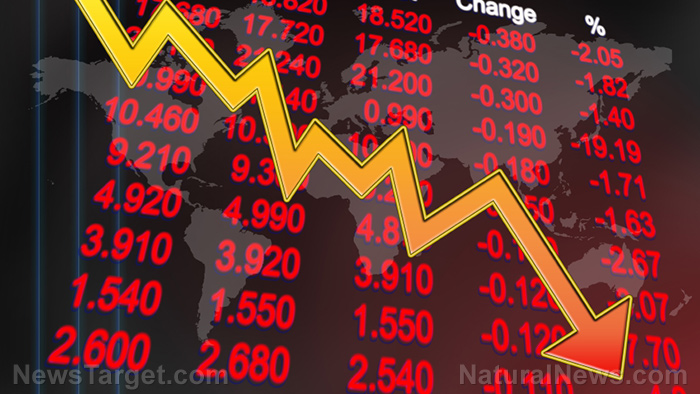Big margin bets driving wild swings in cryptocurrency market
09/07/2021 / By Franz Walker

The wild swings in the values of cryptocurrencies, such as bitcoin, are being driven by more than Elon Musk’s tweets or China’s crackdowns. Instead, traders taking excessive risk in the market being forced to sell when prices go down are thought to be largely responsible for last week’s 30 percent price drop.
Bitcoin, the world’s largest cryptocurrency, suffered a 30 percent one-day drop last Wednesday, May 19. The cryptocurrency fell again on Sunday, May 23, before finally recovering slightly the next day. It still remains down about 33 percent from its previous high.
While initially blamed on tweets by Tesla CEO and cryptocurrency advocate Musk as well as an intensified crypto-mining crackdown by Beijing, analysts are now pointing to traders and the risks they’re taking in the market. In addition, the burgeoning bitcoin lending market has also added to the volatility.
Traders using margin led to bitcoin’s drop
Analysts are pointing to traders using “margin.” This means that these traders are essentially borrowing from their brokerage firms to take a bigger position in bitcoin.
But if the price of bitcoin goes down, these traders have to pay the brokerage firm back in what’s known as a “margin call.” As part of this, there’s often a set price that triggers the selling. This is done in order to make sure traders can pay the exchange back.
According to Brian Kelly, CEO of BKCM, this phenomenon is being led by firms in Asia, such as BitMEX, that allow 100-to-1 leverage for cryptocurrency trades. This is unlike U.S.-based firms such as Coinbase, which only allows margin for professional traders; and Robinhood, which does not allow traders to use margin for cryptocurrency at all.
“You get this crowd factor – everybody’s liquidation price tends to be somewhat near everyone else’s – when you hit that, all of these automatic sell orders come in, and the price just cascades down,” Kelly said in an interview with CNBC. (Related: BITCOIN GREENWASHING: No, Bitcoin mining isn’t mostly powered by clean, renewable energy, but the cult-like self-delusion of Bitcoin apologists is itself a fascinating science experiment.)
As a result of the margin calls, bitcoin traders liquidated roughly $12 billion in levered positions last week as bitcoin’s price spiraled. This resulted in about 800,000 crypto accounts being wiped out.
“Selling begets more selling until you come to an equilibrium on leverage in the system,” explained JMP analyst Devin Ryan. He noted that that selling begins to “compound” as leveraged positions are liquidated. This is because they cannot meet those margin requirements.
“Leverage in the crypto markets – particularly on the retail side – has been a big theme that accentuates the volatility,” he added.
Bitcoin, other cryptocurrencies remain volatile despite recovery
Even as bitcoin made a slight recovery Monday, Wall Street strategists state that the market is still volatile and that its crazy run won’t be over anytime soon.
In May alone, bitcoin has experienced 14 down days, according to Coin Metrics. The cryptocurrency has seen 39 days with daily swings of 5 percent or more in either direction. This is compared to just 42 such days for all of 2020.
“The drubbing that cryptocurrencies have received over the past two weeks is just a taste of things to come,” noted Peter Berezin, chief global strategist at BCA Research. “Crypto markets will continue to face tighter regulation.”
“In the near term, the pain in crypto markets could drag down other speculative assets such as tech stocks,” Berezin warned.
Analysts at JPMorgan concur, saying that the worst of the correction is not in the rearview mirror yet.
“Despite the recovery in prices to around $40k, the momentum signals, and in particular the longer lookback period one, remain problematic as a signal,” said Nikolaos Panigirtzoglou, a managing director at JPMorgan. “It is too early to call the end of the recent bitcoin downtrend.”
Incoming challenges include elevated regulatory scrutiny in the U.S. The Treasury Department recently announced that it was looking into new rules on taxing the movement and sale of cryptocurrency worth over $10,000. At the same time, the Federal Reserve is set to release a paper outlining its own research into central bank digital currencies.
With this in mind, analysts are stating that investors shouldn’t be surprised if bitcoin sells off again to retest the lows from last week.
“A potential retest or even modest undercut of last week’s lows in the near term are entirely possible on China’s Digital Assets crackdown and U.S. regulatory overhang,” said BTIG’s chief equity and derivatives strategist, Julian Emanuel.
Follow BitcoinCrash.news for more on the volatility of the cryptocurrency market.
Sources include:
Submit a correction >>
Tagged Under:
bitcoin, crypto, crypto mining, cryptocurrency, currency, economics, finance, investing, margin, stock market, stocks, trading, Wall Street
This article may contain statements that reflect the opinion of the author
RECENT NEWS & ARTICLES
COPYRIGHT © 2018 GOVERNMENTDEBT.NEWS
All content posted on this site is protected under Free Speech. GovernmentDebt.news is not responsible for content written by contributing authors. The information on this site is provided for educational and entertainment purposes only. It is not intended as a substitute for professional advice of any kind. GovernmentDebt.news assumes no responsibility for the use or misuse of this material. All trademarks, registered trademarks and service marks mentioned on this site are the property of their respective owners.





















